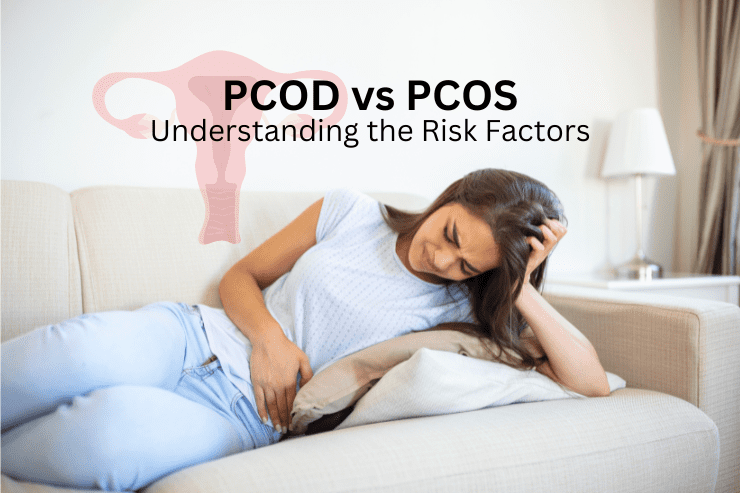People usually get confused between PCOD Full Form (Polycystic Ovarian Disease) with PCOS Full Form (Polycystic Ovarian Syndrome) because of the similarities in their names. PCOD and PCOS Or Also PCOD vs PCOS can both affect the ovaries and cause hormone imbalances.
However, they indicate distinct symptoms and require specific therapies. So, when it comes to PCOD and PCOS, remember: one is a disease, and the other is a syndrome, but it’s always a pain in the ovaries!
With so much false information, many females don’t understand the difference between the two. To get treated well and on time, we are required to know the similarities and distinctions between the two conditions.
Let’s dive deep to know whether you have PCOD VS PCOS and find out which one is more dangerous if not treated on time.
Understanding the difference between PCOD or PCOS
What is PCOD?

Every woman has two ovaries that alternately release an egg every month.
The ovaries produce a very tiny amount of androgens or male hormones.
In PCOD (Polycystic Ovarian Disease), the ovaries release a high excess of underdeveloped or partially-mature eggs, which eventually evolve into cysts.
Common symptoms include abdominal weight gain, irregular periods, infertility, and male pattern hair loss. In this condition, the ovaries typically enlarge and secrete an immense volume of androgens, which can upset a woman’s fertility and health.
The most helpful approach for PCOD often focuses on minimizing the intensity of such symptoms.
What is PCOS?
PCOS (Polycystic Ovarian Syndrome) is a hormonal issue that affects women during their reproductive days.
PCOS is caused by an imbalance of hormones, including an excess of androgens (male hormones), which can lead to irregular menstrual cycles, excessive hair growth, acne, weight gain, and fertility issues.
This condition is like a roller coaster ride – sometimes it’s smooth sailing and other times it’s filled with highs and lows, unexpected turns, and abrupt stops. With proper management and treatment, however, it can be tamed and controlled.
PCOS vs PCOD: 10 Common Symptoms to Diagnose
Several women start noticing symptoms around their first period, whereas others don’t notice after they’ve gained a significant amount of weight or are experiencing trouble getting pregnant.
Females with PCOD or PCOS frequently express the following signs and symptoms:
- Extreme Facial and Body Hairs (including on the back, belly, and chest)
- Irregular menstruation (Oligomenorrhea)
- Darkening Skin (in the groin, neck, and under the breasts)
- Anxiety or Depression
- Skipped or absence of menstruation (Amenorrhea)
- Heavy menstrual bleeding (Menorrhagia)
- Hair loss (hair on the scalp gets lighter and falls out)
- Acne (face, chest, and upper back)
- Weight gain
- Polycystic Ovaries, and Infertility
PCOD vs PCOS: How to differentiate?
To differentiate between PCOD or PCOS, Difference between PCOD and PCOS remember that one is a disease while the other is a syndrome, yet they both cause discomfort to the female ovary. PCOD is a medical condition that affects the hormones and ovaries, In Important Women’s Sex Problems leading to an imbalance of hormones and the formation of cysts in the ovaries.
Difference between Pcos and Pcod
PCOS is a syndrome of hormonal imbalances, including high levels of androgens, that can cause irregular periods, infertility, and other symptoms. (PCOD VS PCOS)
Both PCOD as well as PCOS conditions can cause significant discomfort and can affect a woman’s ability to get pregnant.
What causes PCOD?
The most common Causes of PCOD condition are:
- Excess Insulin
- Excess Androgen
- Obesity
- Genetic Makeup
- High levels of inflammation
What causes PCOS?
The exact Cause of PCOS is unknown.
- Insulin resistance is typical in PCOS patients, and it signifies poor insulin utilization by the body. Increased insulin levels could lead to higher androgen levels in the body.
- Additionally, obesity can worsen PCOS symptoms by raising insulin levels.
- It can be hereditary, if your mother has it there are possibilities that you might have it as well as your sister.
The estimation shows the global prevalence of PCOS is between 4% and 20%. According to the World Health Organization (WHO), approximately 116 million women (3.4%) are affected by PCOS globally.
How to diagnose both conditions? PCOD vs PCOS Symptoms
Both PCOD or PCOS can be diagnosed via health checkup exams which will include a physical exam and pelvic test. The Pelvic Test checks the health of the reproductive organs, from the inside as well as from the outside.
It is recommended by health professionals to regularly take health checkups. While facing any symptoms, you are advised to rush to your nearest gynecologist and take the treatment as soon as possible. Ignorance might lead you into serious trouble.
- Ultrasound: Doctors might take your ultrasound test which uses sound waves and a computer to create an image of tissues, blood vessels, and organs. This test will find out if your ovaries carry any cysts. Ultrasound tests can also assess the thickness of the uterine lining (endometrium).
- Blood Tests: Blood tests will help in probing the high levels of androgen and other hormones that might be affecting the vaginal or your ovary’s health. Get your glucose and cholesterol levels checked as well.

PCOD Diet & Diet Chart for Treatment
- There is no known treatment for PCOD DIET. By changing one’s lifestyle, one can manage the disease.
- A multidisciplinary approach involving a dietitian, gynecologist, endocrinologist, dermatologist, and infertility expert is also required.
- Consistently managing your weight is the most effective way to prevent and treat PCOD. With weight loss of even 5%, the disease can be treated very effectively.
- Patients with PCOD must therefore engage in regular exercise and eat healthily.
- It is recommended to consume food with low sugar and carbohydrate. However, protein and fiber should be consumed in large amounts by PCOD patients.
Treatment for PCOS
Treatment for PCOS depends upon myriad factors. This will include your age, the severity of the symptoms you are facing, along with your overall health. The major risk that PCOS creates is during pregnancy, so if you are planning to get pregnant these treatments might help you.
PCOS Diet? and Diet Chart
Therefore, it is important to discuss treatment options with your doctor prior to becoming pregnant to ensure the health of both mother and baby.
- A change in your diet plan and physical activity. A better and healthy diet with a blend of physical activity will assist you in reducing your weight and the major symptoms that you are facing. Apart from helping your body use insulin more effectively, they may also help you ovulate more often.
- An ovulation-inducing medication. Medications can support the ovaries in producing eggs naturally and regularly. There are also some risks associated with these medications. They may increase the chances of having multiple children (twins or more). Medications can also result in ovarian hyperstimulation. When this occurs, the ovaries overproduce certain hormones. It may result in pelvic pain and bloating in the abdomen.
Conclusion of (PCOD VS PCOS)
Now, you might have an idea whether PCOS is risky or PCOD. Both can become severe if not treated on time. pcod vs pcos They both have quite similar symptoms which is why you are required to reach out to get medical help and get treated as soon as possible.
Professionals will guide you with custom-made diet plans and exercises as per the severity of your condition. It’s better to take professional guidance before becoming a self-proclaimed professional.
A little change in your daily routine, diet, exercise and proper medications can help you treat your conditions on time.


